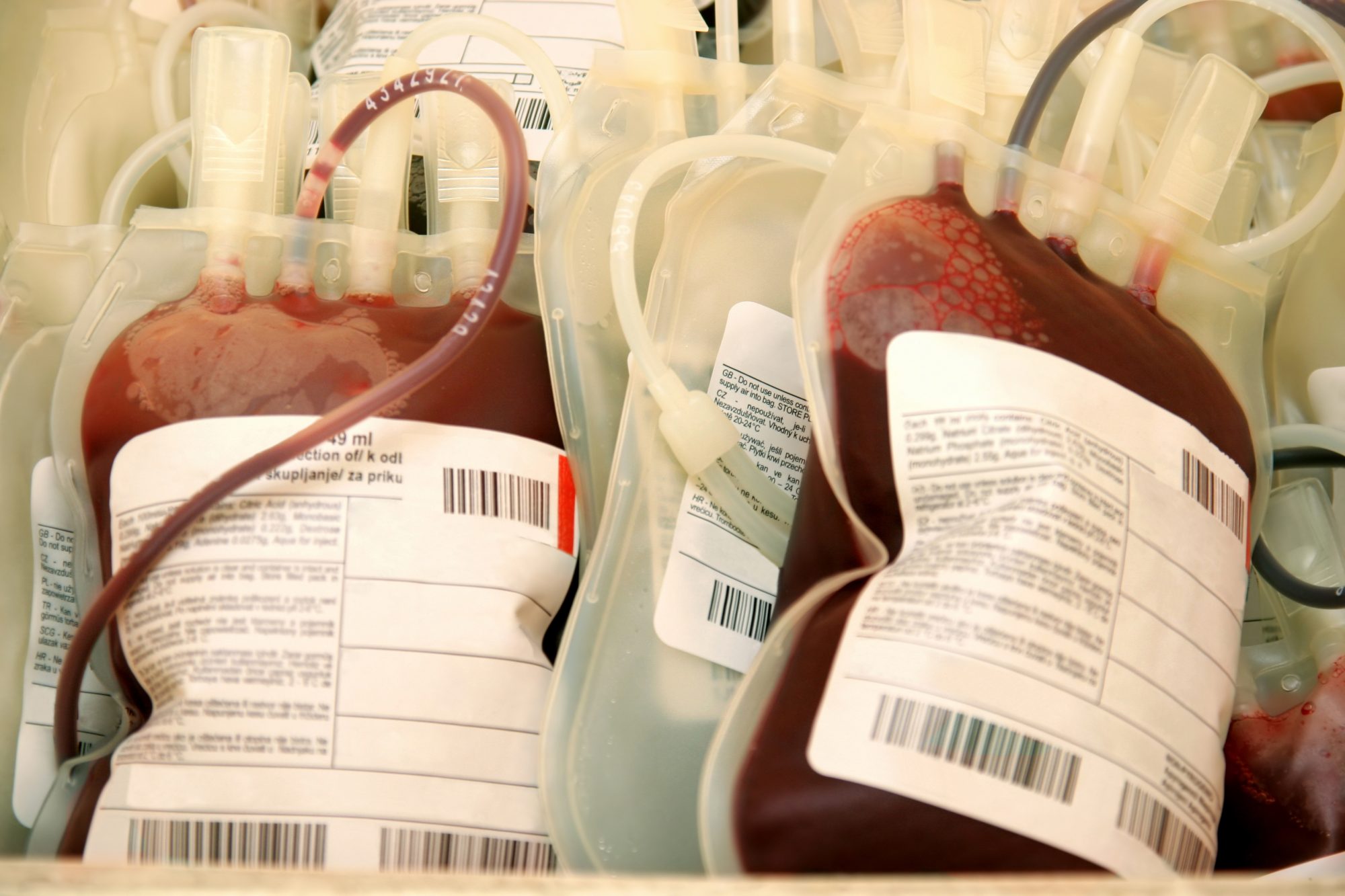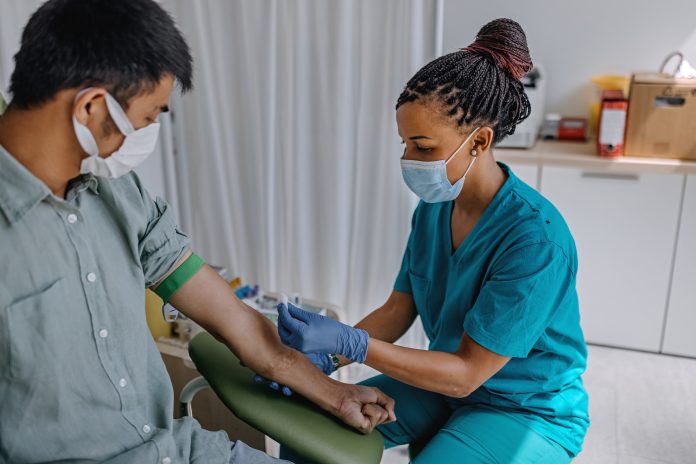Ever thought about giving blood? Around 2.5 million litres of blood are transfused annually in the UK, but do we know about giving blood? Is it safe? What happens when you donate? Are there any risks? Here is all the information you need
The Blood Transfusion service relies on donated blood to save lives. Every year, around 2.5 million litres of blood are transfused in the UK, without which these people would die.
Incredibly – every single unit of blood saves three lives. Most commonly, people need a blood transfusion as part of cancer treatment, during heart or orthopaedic surgery, after a road traffic accident or if they are living with a blood disorder.
In 2022, blood stocks became dangerously low, and the Blood Transfusion Service was forced to issue an Amber alert. As a result, 325,000 people signed up as potential new donors, but only 91,000 took the next step and actually went ahead and donated. The Blood Transfusion Service urgently needs new donors, especially blood from those who are Black, Asian, and other ethnic minorities.
Is giving blood safe?
A huge amount of experience and medical research confirms that giving blood does not harm your health and is perfectly safe. Studies show blood donors tend to have lower blood pressure and lower their risk of cardiovascular disease. Blood donation can even improve cholesterol levels.
The pre-blood donation checks can be regarded as having a medical check-up. You are weighed and measured, your BMI calculated, and your blood pressure taken. You also have blood tests for HIV, syphilis, hepatitis B, C and E, and glycosylated haemoglobin – a screening test for diabetes and prediabetes.
There’s an added advantage, too, in that giving blood brightens and lightens the skin and is good for your complexion.
The act of giving blood means you are engaging with the community. Making social connections is good for human health. It’s surprising how good giving blood – an act of kindness – makes you feel.
Giving blood uses up calories! Each unit of blood removed requires 500 calories to replace it. So, for every five donations – you will lose a pound in weight.
Don’t worry about your body coping with a little less blood. Within a few days or weeks of parting with it, your body will have replenished these blood cells. It takes between 4 – 8 weeks for you to recover fully. But note it only takes 48 hours for you to recover the plasma volume.
Myths about blood donation
Some people wrongly believe they can’t give blood. Here’s a list of common myths about giving blood. The following is not true –
- You can’t give blood if you have high blood pressure
- You can’t give blood if you have high cholesterol
- You can’t give blood if you have tattoos
- Vegans and vegetarians can never give blood
- You can’t give blood if you take medication
- You can only give blood once a year

What happens at the blood donation appointment?
The process starts with giving you 500 ml of fluid to drink over 5 -10 minutes to ensure you are well-hydrated. A Donor Safety Check form will have been sent to you in the post, and you need to fill this out beforehand and bring it with you on the day. You will be given more information and asked to read the Donor Consent Booklet. You can change your mind at any time. A blood test is taken to check your haemoglobin (iron pigment) level and ensure you are not anaemic. You won’t be permitted to donate if you don’t have enough haemoglobin.
Next, you will be seated comfortably in a chair. A blood pressure cuff will be slightly inflated on your arm to make sure there is adequate pressure in the arm throughout the donation. The next step is to clean your arm with an antiseptic wipe, locate a suitable vein, and insert a cannula ( a small piece of plastic tubing). The staff will only make one attempt to do this. For most people, this is not too painful. A full blood donation is 480 ml and takes 5 -10 minutes. You are attached to a machine called an agitator, which measures the donation and automatically stops collecting blood when it reaches the maximum. The cannula will then be removed, and a dressing will be applied to your arm. You are then asked to rest for 15 minutes and given drinks and snacks before leaving home.
Who can and who can’t give blood
NHS Blood and Transplant have criteria for who can and can’t give blood.
You can give blood so long as you are;
- Fit and healthy
- Aged 17 – 65
- Weigh between 7 stone 12 lbs (50kg) and 25 stone (158kg)
- Have suitable veins
- Meet the eligibility criteria, which will be checked with you before you donate
You can’t give blood if you’ve
- Had most types of cancer
- Have some specific heart conditions
- Have received blood, platelets, plasma or any other blood products since 1st June 1980
- Have tested positive for HIV
- Had a solid organ transplant
- Are a carrier for hepatitis B or C
- Have self-injected drugs, including non-prescribed bodybuilding and tanning agents
This list is incomplete. For other medical conditions which mean you can’t donate, click here.
What are the risks of blood donation?
Although there are some risks when donating blood, most are not common and are generally minor. Most people donate without any particular problems.
Here’s a list of what can happen in order of frequency.
Common (1 in 10/1 in 100)
- Feeling faint
Uncommon (1 in 100 – 1 in 1000)
- Bruising
- Fainting
- Nerve irritation – there’s always a small risk whenever blood is taken
- Arm pain
- Swelling or arm pain because of fluid leaking into surrounding tissues, or a mild citrate reaction, but this only occurs if you have a plasma or platelet collection.
Rare ( 1 in 1,000 – 1 – 10,000)
- Delayed bleeding
- Local allergic reaction
- Any event requiring outside medical care
- Moderate citrate reaction but this only occurs if you have a plasma or platelet collection.
Very rare(1 in 10,000 to 1 in 100,000)
- Piercing an artery
- Local inflammation of the vein
- Chest pain
Exceptionally rare (1 in 100,000 – 1 in 1,000,000
- Cellulitis – bacterial skin infection
- Nerve injury resulting in prolonged periods of pain or weakness
- A clot in the deep veins of the arm – uncommonly, the clot may travel to the lungs
- Symptoms are due to the return of damaged red cells, or a severe citrate reaction but these only occur if you have a plasma or platelet collection.
Less than 1 in 1 million
- Major anaphylactic reaction
- Major blood vessel or tendon injury
- Symptoms due to the return of damaged red cells, or a severe citrate reaction but these only occur if you have a plasma or platelet collection
- Symptoms from air entering the vein – air embolus
Tips to ensure your donation is problem-free
Here’s a few tips on what to do to ensure your blood donation is problem-free
- Drink plenty of water before your visit so you start off well-hydrated. This helps the staff to find your veins easily and helps prevent you from getting lightheaded during the procedure.
- Don’t skip any meals – make sure you’ve eaten properly before arrival to keep your blood sugar level up.
- You can exercise before you arrive to give blood but not immediately after as this might encourage you to feel dizzy or faint.
- Make sure you eat a healthy diet containing iron-rich foods along with vitamin C, which helps you absorb iron. You need to leave 3 months before your next donation.
- Avoid hot baths and showers for the rest of the day after your blood donation, as this could make you feel faint.
How to start the process of being a blood donor
If you would like to give blood, you can sign up here. After your first appointment, you can find out your own blood group. You can exercise before you arrive to give blood but not immediately after, as this might encourage you to feel dizzy or faint.
- Make sure you eat a healthy diet containing iron-rich foods along with vitamin C, which helps you absorb iron. You need to leave 3 months before your next donation.
- Avoid hot baths and showers for the rest of the day after your blood donation, as this could make you feel faint.
How to start the process of being a blood donor
If you would like to give blood, you can sign up here. After your first appointment, you can find out your own blood group.
Personal view
If you are thinking of giving blood, there’s no time like the present. My husband has had lymphoma and a bone marrow transplant. We are so grateful to all those who donated the blood products he received during treatment. Giving blood is safe, simple, and very rewarding. The benefits far outweigh any disadvantages – and who knows – it could be you one day or someone you love, who needs that blood transfusion. You might also think about joining the bone marrow registry.
For more information
- NHS Blood and Transplant – Give Blood – Let’s Save Lives Together
- British Bone Marrow Registry











